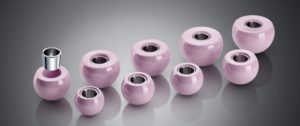CeramTec GmbH is the owner of the color trade mark IR 1‘109‘076 claiming protection for a shade of pink (Pantone 677, see image). At the beginning of 2012, CeramTec applied for the extension of protection to Switzerland for said trade mark in connection with goods of class 10: “femoral head spheres, acetabular cup, all the aforesaid goods exclusively for sale to implant manufacturers“.
The Swiss Federal Institute of Intellectual Property refused protection because the claimed color lacked original distinctiveness, arguing that it would be considered for its aesthetic function and not as an indication of origin. Secondly, the Institute ruled that the applicant had failed to show acquired distinctiveness through use in Switzerland.

Actual use of the mark for femoral head spheres
The Swiss Federal Administrative Court dismissed CeramTec’s appeal and confirmed the decision of the Swiss Federal Institute of Intellectual Property. In its decision, the Court took an in-depth look into the original distinctiveness of the color and potential acquired distinctiveness through use in Switzerland.
Distinctiveness needs to be assessed in relation to the claimed goods and services, and from the relevant market player’s perspective. Contourless colors can be distinctive and thus be registered as trade marks;, however, colors primarily have an aesthetic function and cannot automatically be considered as an indication of the commercial origin of the goods. Only when a color or a combination of colors is so unexpected and unusual is it distinct ab initio.
In the present case, CeramTec claimed to be the only manufacturer of pink femoral head spheres and acetabular cups. Whether or not this is true, the Court denied the distinctiveness because the claimed color tone is a pale pink that does not considerably differ from the usual white or cream-colored products. The relevant market players may even notice the difference from other products, but the color choice is too similar to the standard colors for CeramTec’s sign to be considered an indication of origin.
The Court went on to analyze whether the color trade mark, in connection with the concerned goods, had acquired distinctiveness through use in Switzerland.
CeramTec failed to prove the acquired distinctiveness of its color mark in a credible manner through a demographic survey it had conducted principally because the survey was conducted at a conference held in Germany, and it remained unclear how many (if any) of the surveyed physicians practiced in Switzerland. Furthermore, the documents showing the meaningful number of sales in Switzerland were not considered to show that the color is well-known in connection with the claimed goods.
_____________________________
To make sure you do not miss out on regular updates from the Kluwer Trademark Blog, please subscribe here.



